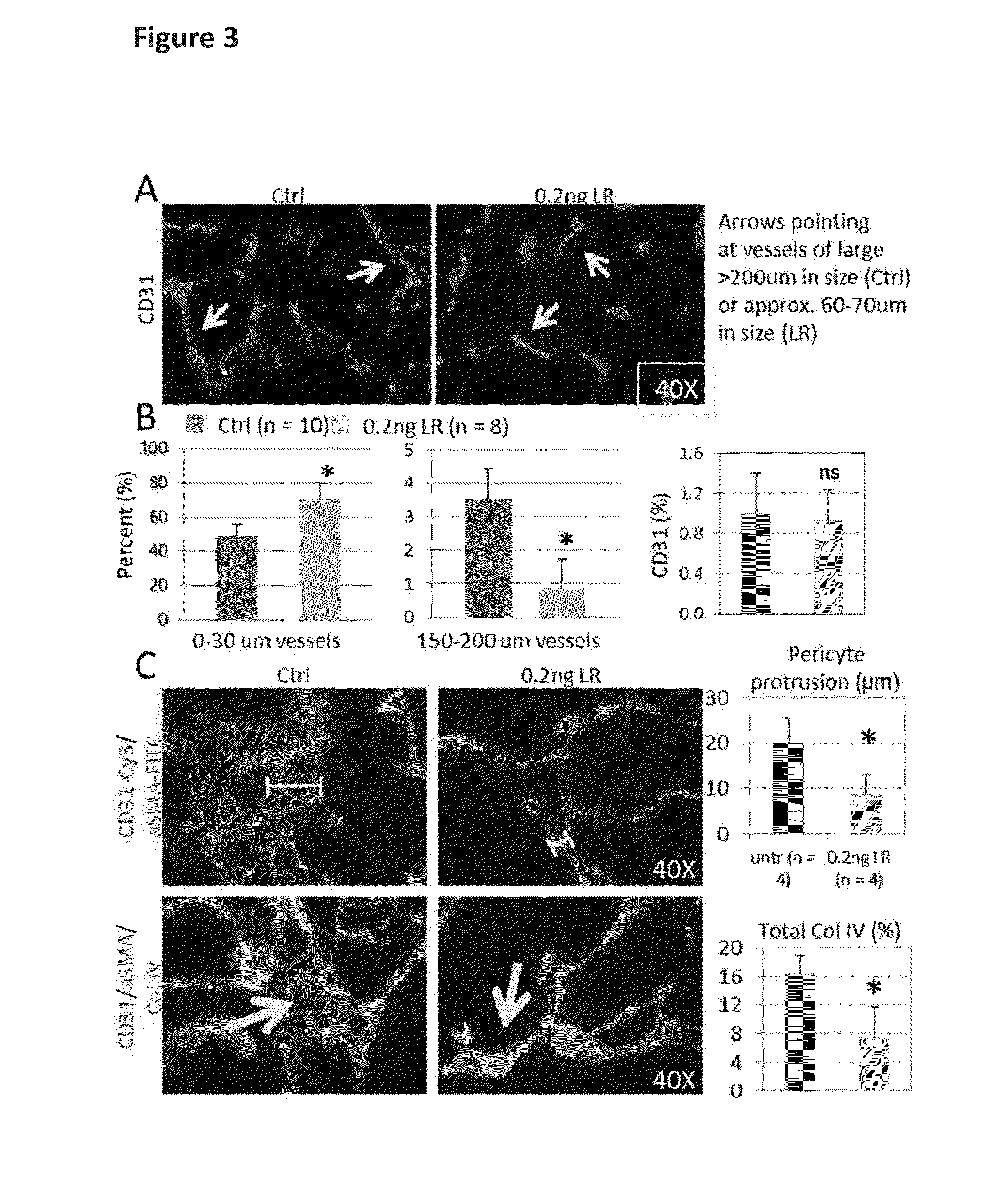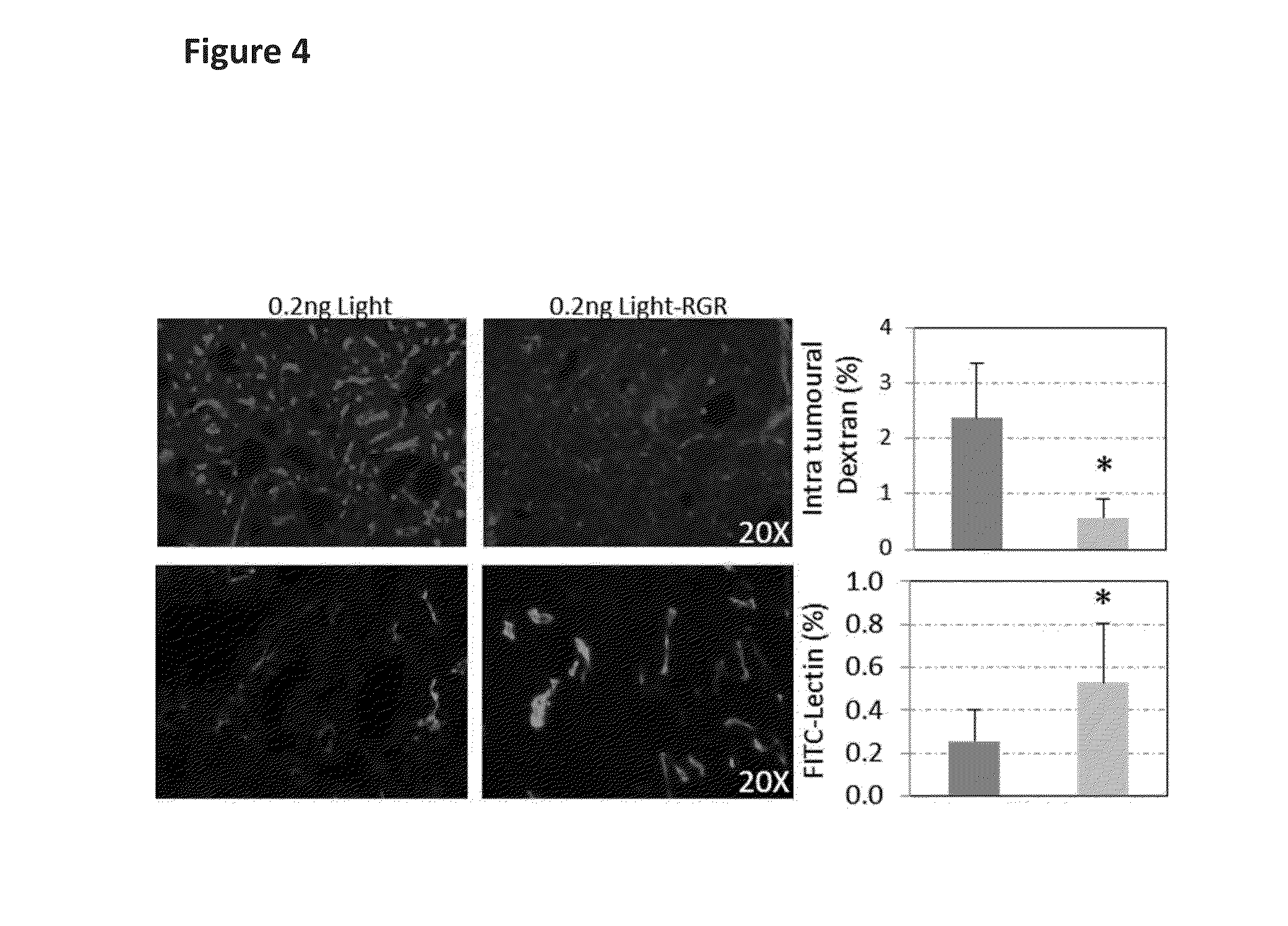Treatment of tumours using peptide-protein conjugates
a technology of peptide and tumour, applied in the field of tumour treatment, can solve the problems of structural and functional abnormality of the tumour vasculature, leakage of the vessel, interstitial hypertension, etc., and achieve the effect of improving the vascular function of the tumour and increasing the survival time of the patien
- Summary
- Abstract
- Description
- Claims
- Application Information
AI Technical Summary
Benefits of technology
Problems solved by technology
Method used
Image
Examples
example 1
Short Term and Long Term Treatment of RIP1-Tag5 Mice with 0.2 ng LIGHT-RGR
Short Term Treatment
[0123]0.2 ng LIGHT-RGR when injected a total of four times into tumour-bearing RIP1-Tag5 mice normalized chaotic tumour vessels (FIG. 3) as determined histologically.
[0124]As shown in FIGS. 3A and 3B, a shift from large to small caliber tumour vessels (i.e. a selective loss of large vessels) was observed, without affecting total vessel counts (as determined using CD31 as a vessel marker).
[0125]Pericytes are support cells that wrap around endothelial cells of the blood vessels. A classical feature of chaotic tumour vessels is the protrusion of pericytes into the tumour parenchyma (see FIG. 3C). In contrast, firm attachment of pericytes to vessels was observed in LIGHT-RGR treated tumours (FIG. 3C). This pericyte re-attachment to vessels was accompanied by close vessel alignment of collagen IV, which also indicates normalization of the vascular bed, in addition to improved endothelial cell / pe...
example 2
Short Term and Long Term Treatment of RIP1-Tag 5 Mice with 20 ng LIGHT-RGR
Short Term Treatment
[0135]Short term treatment of tumours in RIP1-Tag5 mice with 20 ng LIGHT-RGR induced the formation of ectopic lymph node structures (CD45 / B220+ lymphocytes, FIG. 9) associated with high endothelial venules (HEVs) as recognized immunohistochemically by the marker MECA79 (FIG. 9). HEVs serve as portals for the mass transit of lymphocytes in and out of activated lymph nodes and heavily inflamed tissues. This is the first demonstration of HEV formation in tumours in response to a single therapeutic agent.
[0136]Specifically, following short term treatment with 20 ng LIGHT-RGR HEV structures were observed in 60-75% of RIP1-Tag5 tumours, with intratumoural areas surrounding the HEVs heavily infiltrated with T cells and B cells. Interestingly, T cells which infiltrate tumors comprise CD4+ and CD8+ populations which also includes PD-1+ and CTLA4+ T cells and regulatory T cells as analyzed by FACS (d...
example 3
Effect of LIGHT-RGR on Murine Breast Cancer Tissue Vasculature
[0141]Murine breast cancer cells (5×106, 4T1 from ATCC) were injected orthotopically into the mammary fat pad of Balb / c mice. After tumours became palpable, mice were treated for 2 weeks with bi-weekly injections of 20 ng LIGHT-RGR i.v. Mice were injected with pimonidazole (hypoxia marker) and FITC-labelled lectin. After 1 h / 10 min (pimonidazole / lectin, respectively) circulation, mice were perfused with 2% formalin and tumors dissected and fresh frozen in OCT compound. Tumours were analyzed by histology for vessel frequency (CD31), quality of vessel perfusion (CD31 plus lectin-FITC), caldesmon (contractile pericyte marker) induction and frequency of intratumoral hypoxia (pimonidazole staining). 0.2 ng LIGHT-RGR reproduced all aspects of vessel normalization as shown for RIP1-Tag5 mice. However in the breast cancer model, due to lower binding affinity to tumor vessels, a dose of 20 ng LIGHT-RGR was required to recapitulate...
PUM
| Property | Measurement | Unit |
|---|---|---|
| body weight | aaaaa | aaaaa |
| weight | aaaaa | aaaaa |
| size | aaaaa | aaaaa |
Abstract
Description
Claims
Application Information
 Login to View More
Login to View More - R&D
- Intellectual Property
- Life Sciences
- Materials
- Tech Scout
- Unparalleled Data Quality
- Higher Quality Content
- 60% Fewer Hallucinations
Browse by: Latest US Patents, China's latest patents, Technical Efficacy Thesaurus, Application Domain, Technology Topic, Popular Technical Reports.
© 2025 PatSnap. All rights reserved.Legal|Privacy policy|Modern Slavery Act Transparency Statement|Sitemap|About US| Contact US: help@patsnap.com



